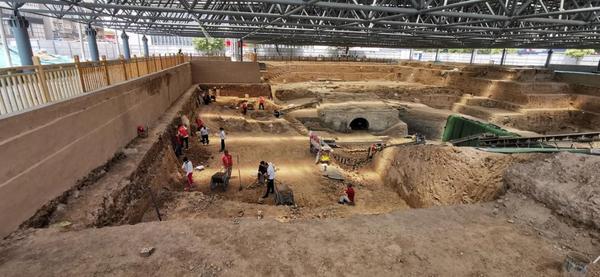Archaeologists have excavated the ruins of house foundations dating back more than 5,000 years in the Yangshao village site in Central China’s Henan-province last month, adding another finding about the ancient civilization in the region.
The house was once a large building with rammed earth walls that might have covered more than 130 square meters. It is speculated that it belongs to the late Yangshao Culture period, says Li Shiwei from Henan Provincial Institute of Cultural Heritage and Archaeology, who is in charge of the excavation site.
“This is the first time that large house ruins have been discovered since the excavation of the Yangshao village site in 1921. The findings can provide new materials for studying the types, shapes and building techniques of houses during the Yangshao Culture period,” Li said.
Archaeologists also unearthed four artificial trenches and a large number of cultural relics at the site, including a jade tomahawk that symbolizes military power.
In 1921, the first excavation on the Yangshao village site, which is in Mianchi county, Henan province, marked the birth of modern-Chinese archaeology. Originating around the middle reaches of the Yellow River, the Yangshao Culture is considered an important stream of Chinese civilization and the fourth archaeological excavation at the site began on Aug 22, 2020.
In September 2022, a rare 3,000-year-old gold mask has been unearthed recently providing a glimpse into ancient Chinese culture during an excavation of royal tombs. The mask threw light on the artifact dates back to the Shang dynasty—the earliest ruling dynasty ever recorded in China—from 1600 to 1046 BCE.
Since there was hardly any gold artifacts uncovered from this period, the finding of a gold mask remains exceptionally rare. In fact, a similar metal mask was discovered at the Sanxingdui archeological site in autumn 2021, making the site a treasure trove of artifacts of the ancient Shu Kingdom dating from the years 221 to 263 CE. The site was discovered in 1929 and since then archaeologists have uncovered numerous, rare artifacts from the ancient kingdom.
But this new Henan discovery older than the artifacts of the Shu Kingdom. It is likely that the artifacts within Sanxingdui were directly influenced by those of the Shang Dynasty. Known as the birthplace of Chinese civilization and is home to four ancient cities, the mask is likely to throw light on the region’s capital, Zhengzhou.

Experts believe the newly discovered gold mask would have covered the whole face. It is not clear what exactly the mask would have been used for but the Shang Dynasty was particularly well-known for its development of artifacts used in warfare. Archeologists are not sure whether the mask was made locally or obtained from elsewhere.
Director of the Zhengzhou Municipal Research Institute of Cultural Relics and Archaeology, Gu Wanfa, told the South China Morning Post that the find shows a direct influence between the finds at Sanxingdui and the finds in Zhengzhou.
“There has been a saying about bubaijinshen, or an imperishable gold body, since ancient times in China. [The mask] proves that the concept had existed since the Shang dynasty,” Wanfa told the South China Morning Post.
Earlier, archeologists also discovered plaques and gold leaves in the royal tombs in Zhengzhou, besides some coins and bronze weapons. The Shang dynasty is noted for its bronze artifacts and also thought to have invented first forms of writing.
 India International Times Latest Business News from India
India International Times Latest Business News from India





